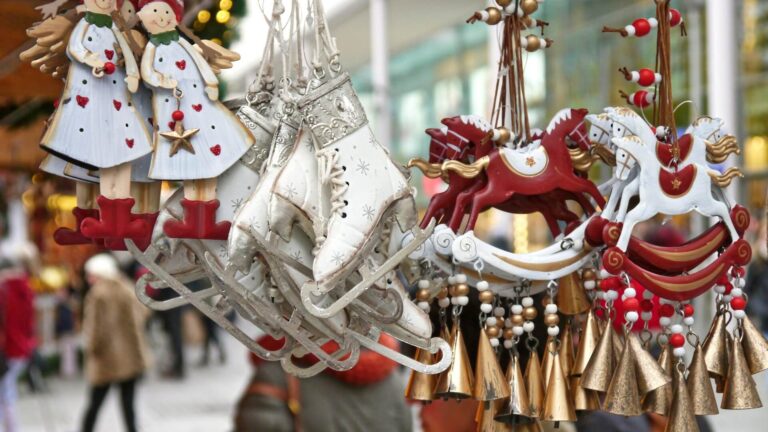
If you need a freelance travel writer or you would like to see your country, city, flight, etc., presented on the blog, drop me an email.
Find our more on Freelance Travel Writer page.
If you are planning on visiting Andalusia, make sure to read about things to do in Cordoba, Spain – since this is where it all started! The city’s monuments moved me in such a way that I got goosebumps when walking among Mezquita columns and the caliph’s palace remains.
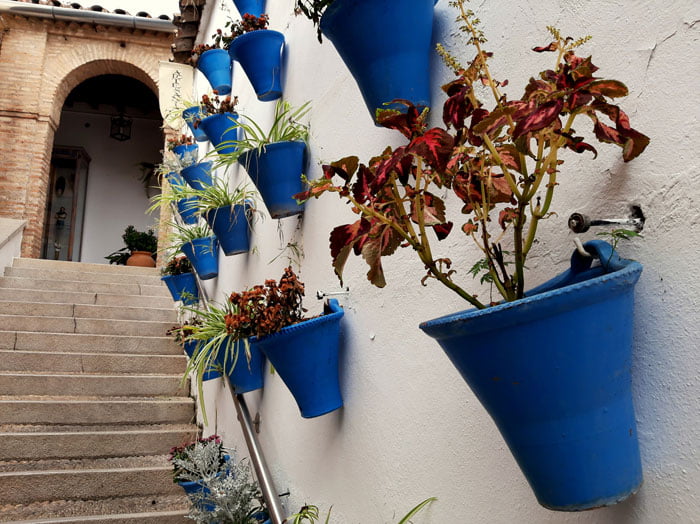
CORDOBA CITY
Established by Carthaginians, the town truly developed under the Romans who founded the colony here in 169 AD. This was the northernmost point that could be reached by Guadalquivir river which made Cordoba an important trading center for olive oil, wine and wheat. Visigoths and Byzantines inhabited the area from the 6th century when in 716 the town was declaired the capital of Al Andalus province under the Moorish rule. This was also the capital of the newly established Caliphate in 929. In 1236 Cordoba was conquered by the Catholics.

There is something about the fact that Cordoba under Moors was one of the largest cities in western Europe. Its population exceeded 500,000 in the time when Granada was populated by a mere 26,000. Also, the city was much bigger than today! Cereals, olives, figs, rice, and oranges were exported to the east.
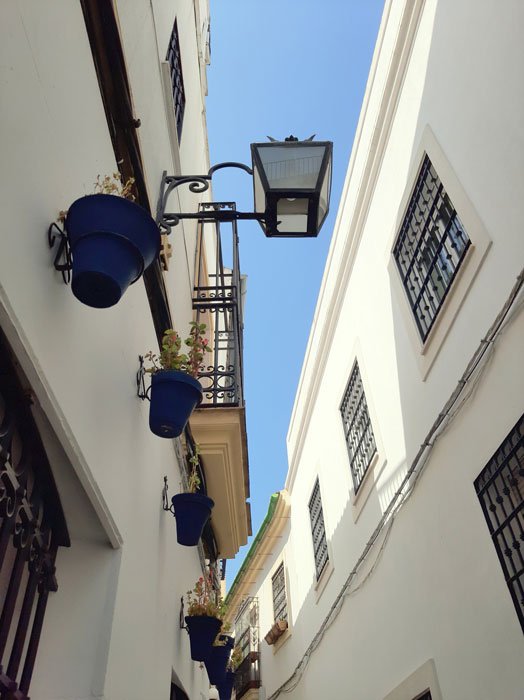
The jewelry business flourished with an abundance of gold, ivory, and jade. Two new industries began here in the 11th century – the production of paper and glass. The process of specific glass manufacture was kept secret for centuries allowing Andalusia to hold a monopoly in this kind of production. The Caliphate library held over 400,000 books… So, there is no way to be indifferent when walking along the same streets today!
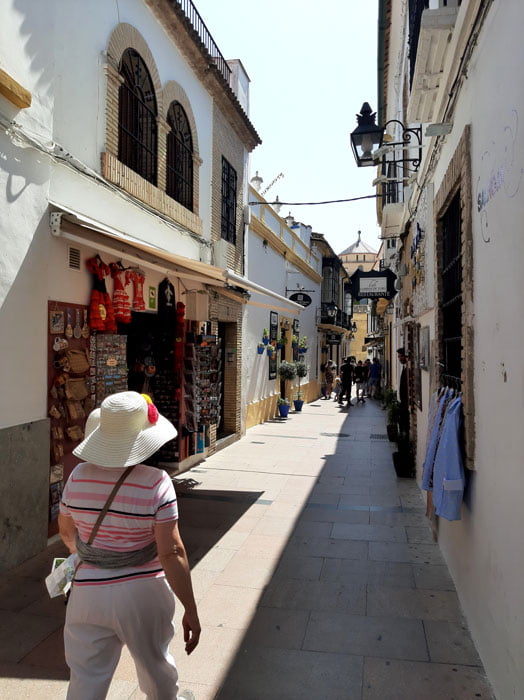
LA MEZQUITA
Building of the mosque began in 780 AD under the rule of Abd Rahman I, but it wasn’t until Abd Rahman III and the 10th century that it got all its splendor. This is when Cordoba reached its zenith, outshining Byzantine and Baghdad with its scientific and cultural development.
There are 1,300 marble, jasper and granite columns here, which were mostly taken from Roman and Visigoth temples. They hold 365 bicolored arches.
After conquering the region, Christians destroyed central part of the Great Mosque of Cordoba in order to build chapels. The Renaissance Cathedral dates back to the 16th century.
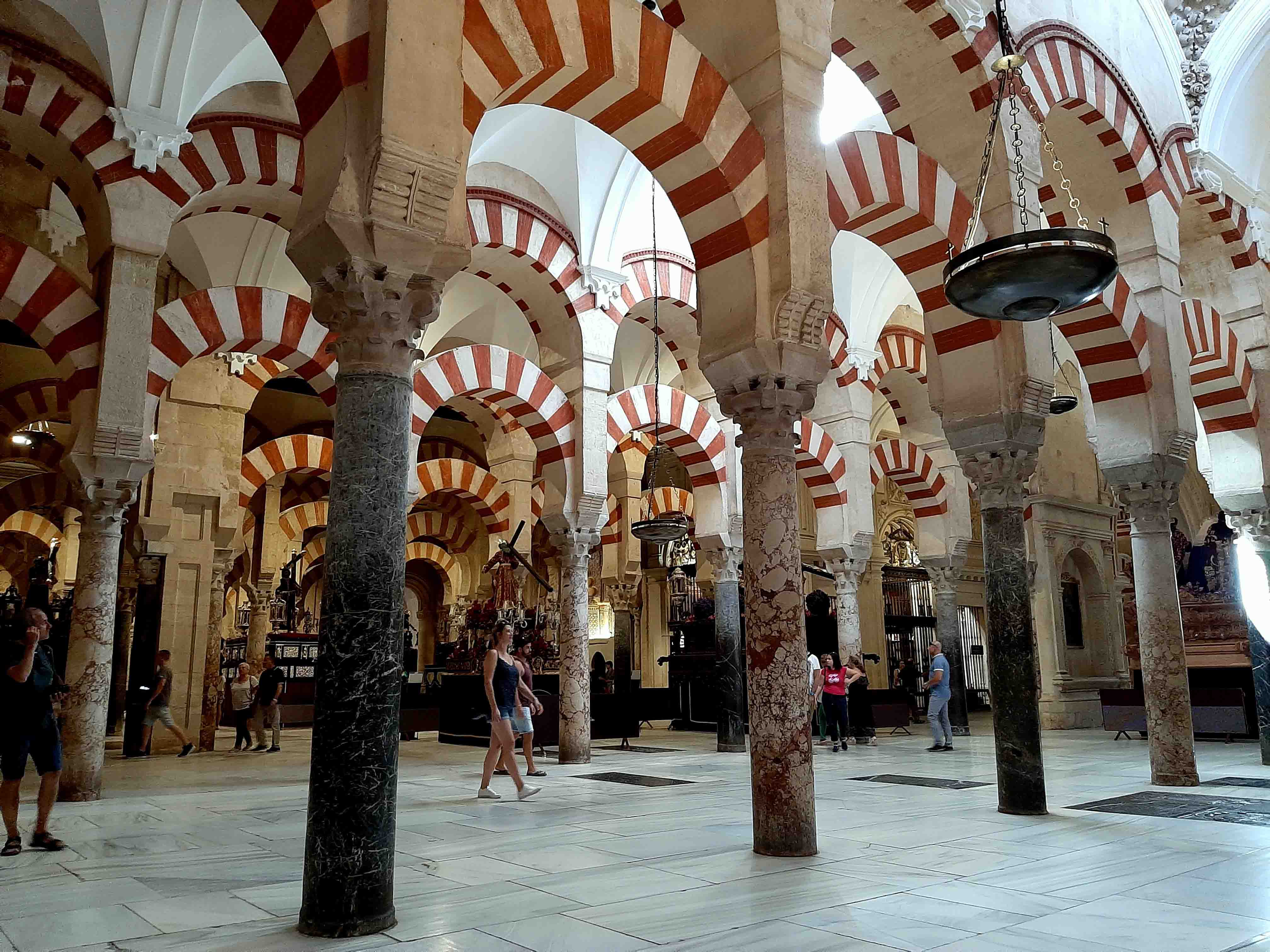
They say that in the Moorish times all 19 doors of the Mezquita towards the courtyard of the Patio de los Naranjos were open, creating the impression that columns inside were a certain extension of the orange trees outside, while the sunlight and shadows added to the surreal ambiance.
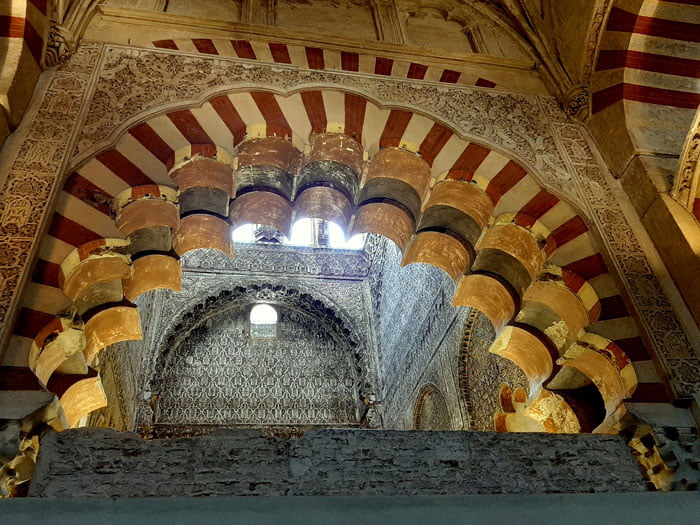
I read somewhere that Abd Rahman escaped from the Middle East via northern Africa when his family was killed. They were the Umayyads, members of the same dynasty who built the Grand Mosque in Damascus Syria at the beginning of the 8th century, and Al Aqsa in Jerusalem. Remembering how excited I was when I visited the Syrian Grand Mosque years ago, I couldn’t wait to step into the one of Cordoba.

TIP: The Mezquita entrance tickets are sold in the courtyard and they cost 10 Euros. Audio-guide is available for another 4. The complex can be entered for free from 8,30 to 9,30 in the morning during the service, but individually and in silence.
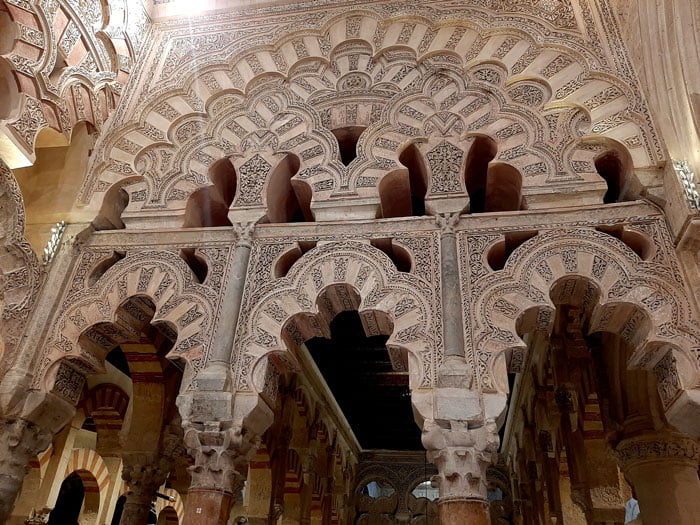
La Mezquita has always been a synonym for Andalusia for me and an obligatory stop on the things-to-do-in-Cordoba list. I knew that I would be impatient to get to the city once I visit the south of Spain and that I would rush between the mosque’s columns. That’s exactly what happened!

After arriving from Granada by bus (the ride took 2,5 hours through a vast olive grove landscape), and left my things in the room (the accommodation was central with two huge windows overlooking the narrow streets), I asked for the Mezquita directions.
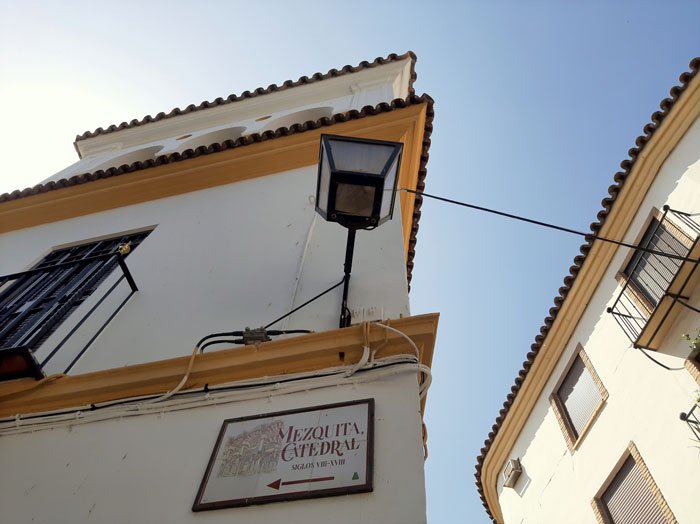
Ten minutes later I was on my way through cobblestone streets, arriving at strong walls surrounded by souvenir shops and restaurants. The gate on my left. Tourists. A few steps up and I was in the Patio de las Naranjos (or the Orange Tree Courtyard).
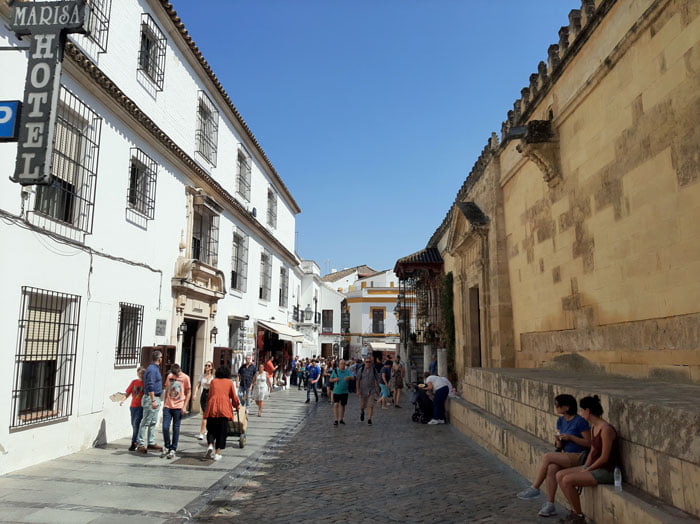
TIP: Entrance to the courtyard is free, you can rest in the orange trees’ shade, by the Andalusian fountain, and with the sound of birds singing in the background.
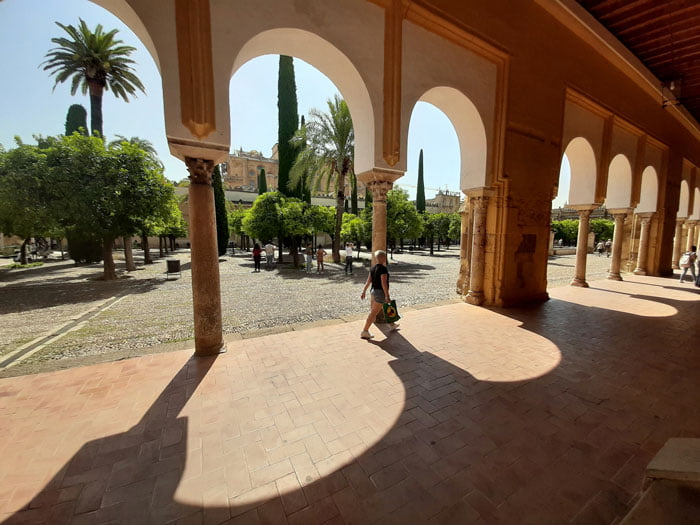
I don’t think that I was this excited throughout the whole of my Andalusia journey as I was when purchasing the Mezquita ticket. I left my passport at the counter (in order to get the audio guide you should leave an ID), thinking: „Sure, whatever it takes!“ Another few steps to take, I smiled at the security and peeked inside. The sunbeam spread over the elegant columns that were sticking out of the shadow.
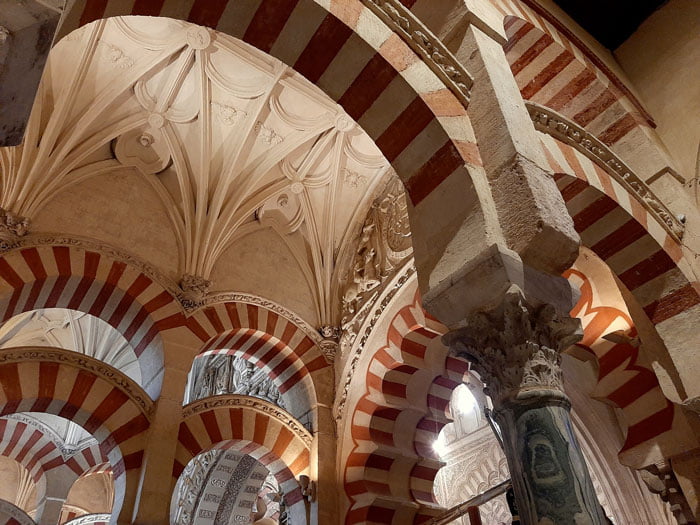
„Incredible…“
Tourists were all looking up into ceilings and bicolored arches, trying to find their way through this surreal forest of columns. Step or two further, and I touched one of them.
“I can’t believe I’m finally here!”
Touching the marble gave me goosebumps and I got slightly dewy-eyed.
“Oh, I knew that the Mezquita would give me such an impression. Well, welcome, Danijela!”
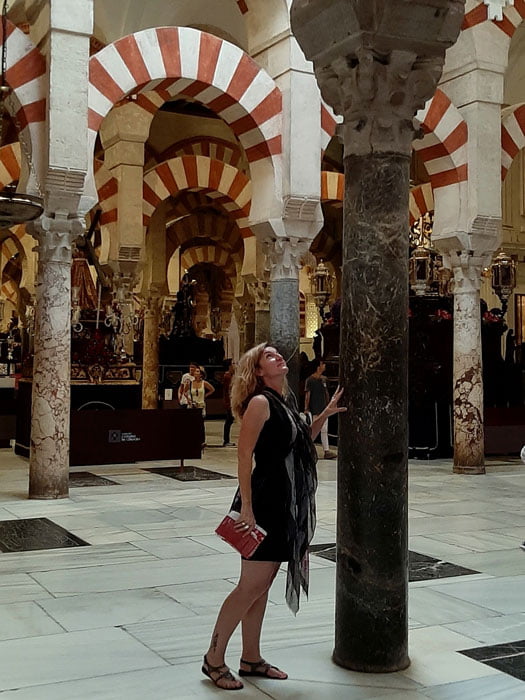
Visiting the Mosque-Cathedral is estimated to about two hours. (Dare I mention that it took me – four?) When I walked through its huge hall at the end of September, Spaniards were getting ready for the upcoming religious holiday, installing decorative figures of Christian saints among the columns. Even though it did give an additional charm to the Mezquita ambiance, with all the respect to the installments – they seemed a bit kitschy compared to the simple elegance of the Moorish architecture.
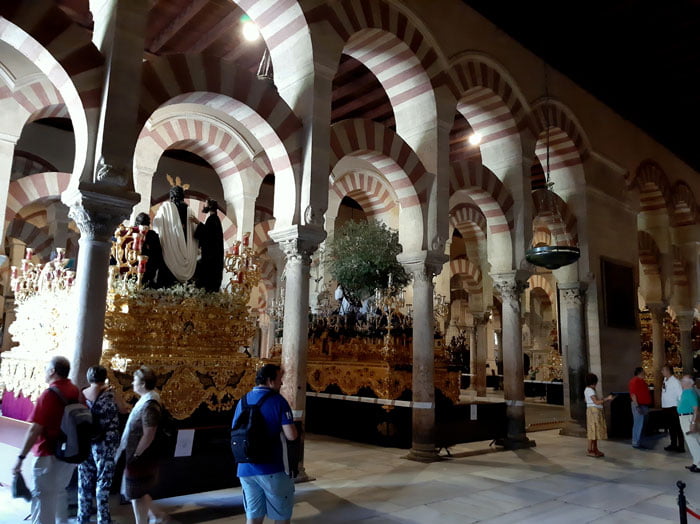
Try to notice the difference between columns, they can almost tell the story of some ancient temple they were incorporated into before adding to the mosque’s beauty. The mihrab area was just mesmerizing, so decorative and detailed in golden nuances.
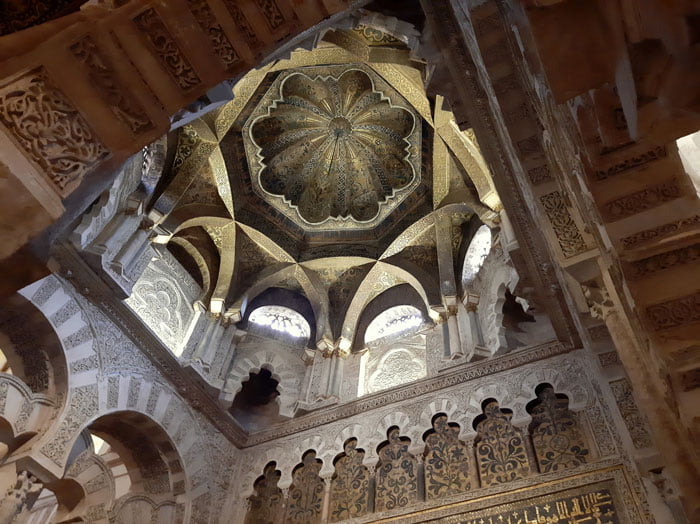
Surreal arches, and more arches in other arches, beams from the courtyard and through the ceiling holes, and numerous small lanterns. In the middle of the mosque, you will find the Cathedral. They say that the conqueror of Cordoba gave permission for the church to be built here, but when he saw what they did, he immediately regretted it. Nevertheless, this is where the Cathedral stands with whitish arches and Renaissance decorations. An odd mixture that now represents a unique historical monument.
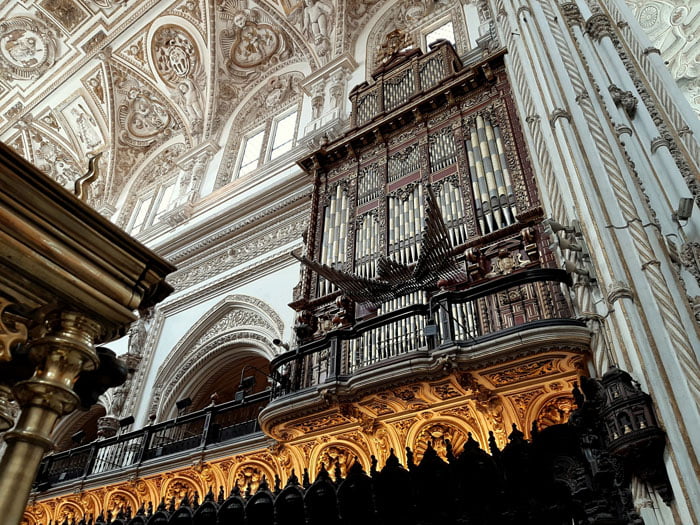
MADINAT AL ZAHRA
This grandiose palace 7 km away from the city, was built by 10,000 workers under the rule of Abd Rahman III in 936. Although the caliph’s palace stood only for 70 years, it was renowned for splendor and luxury that were not to be seen anywhere in Europe. At the same time, Madinat al Zahra is the largest archeological site in Spain covering 112 hectares. The town was destroyed and plundered in the 11th century, but nothing else was built above its ruins for nearly 1,000 years during which it was forgotten and covered with earth. It was declared World Heritage Site by UNESCO in 2018.
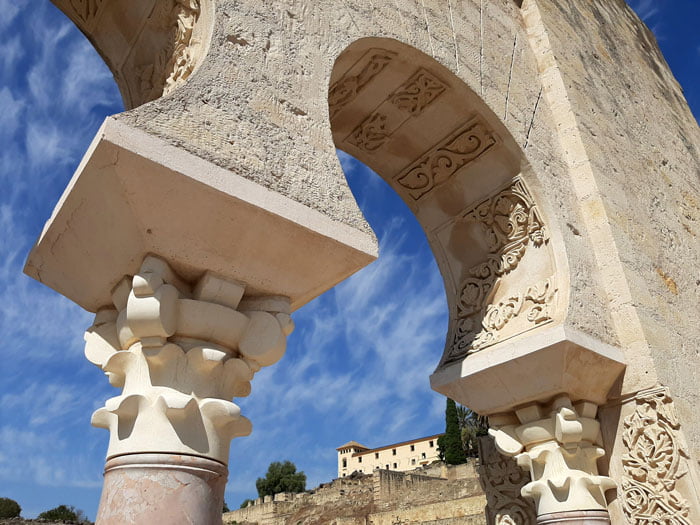
“Zahra” in Arabic means shining or brilliant, and so, the romantic story says that this is how the caliph referred to his favorite mistress, and thus he named the palace after her. Still, the word is also used in Arabic to refer to wealth and political power which often made rulers choose the name for states’ institutions.
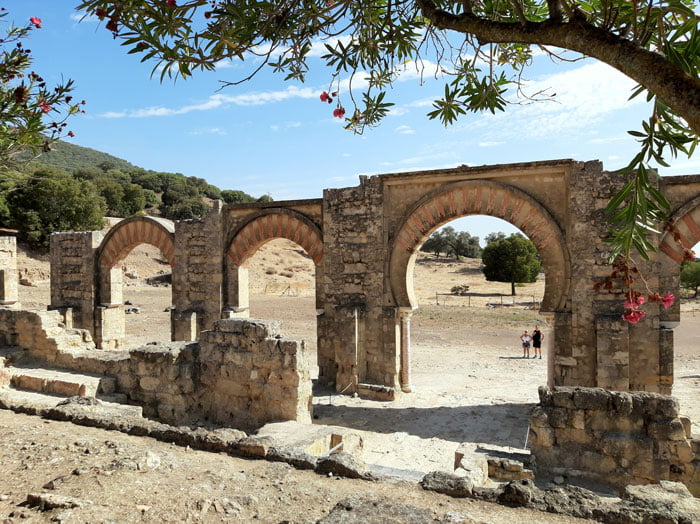
When walking through the halls of the former palace today, one can say that there is a little bit of both. Because some romance slipped into all that power and luxury, at least when the architecture is concerned. The other legend says that when European ambassadors came to visit the caliph, they were led from one majestic hall to the next, abundant in fountains, food, greenery, people and trade, columns, arches, and decorative ceilings.

When after a few hours they would finally be brought before the caliph – in the throne room with mercury fountains where they could see their faces’ reflections, the throne that the ruler could rise in order to be above his subjects, and so many intricate details on every centimeter of walls and ceilings – the effect was achieved, they were stunned by something they have never seen before!
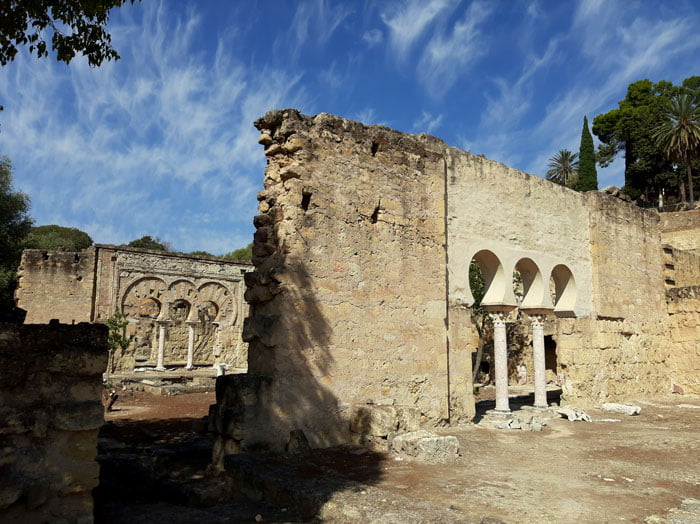
TIP: Stop by the Tourist Information Center before heading to Madinat al Zahra because this is where you will get a “yellow” bus ticket. It costs 9 Euros and there are two stations at the Paseo de la Victoria.
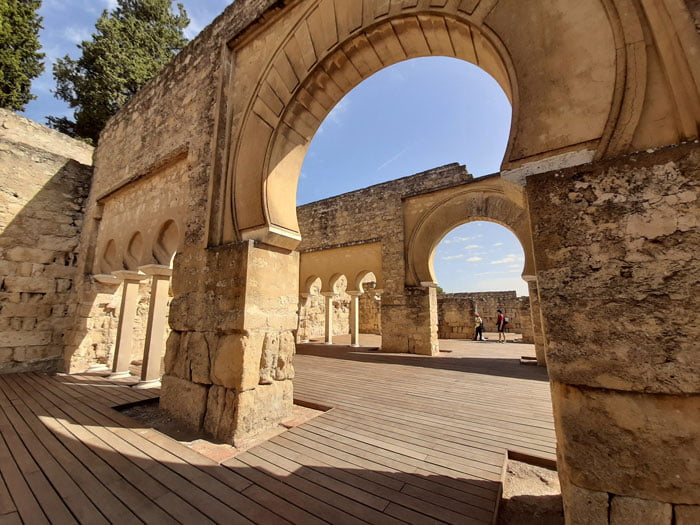
Similarly, I entered one room and the next came into the area once occupied by the ruler’s residence, leaned towards the column – and got those goosebumps again!
“I can’t believe what Cordoba does to me, amazing!”
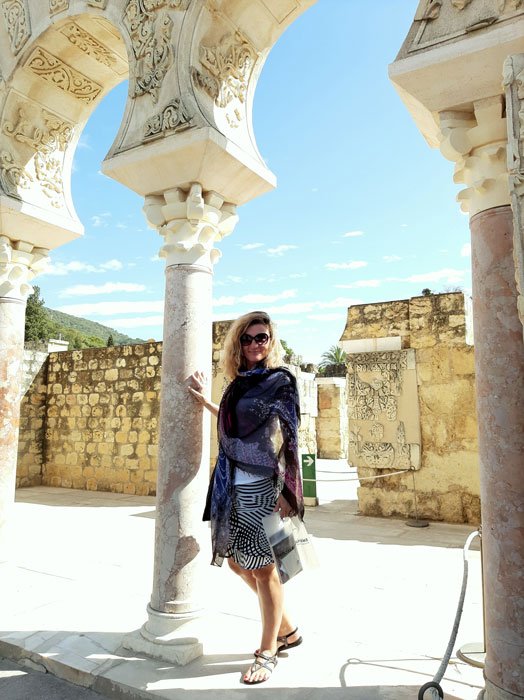
The Madinat al Zahra visit has to be planned in advance because you will take a special bus ride, if not coming in your own car. The ride takes about 20 minutes and the bus will take you to the museum complex where details related to the site are displayed, along with its remains.
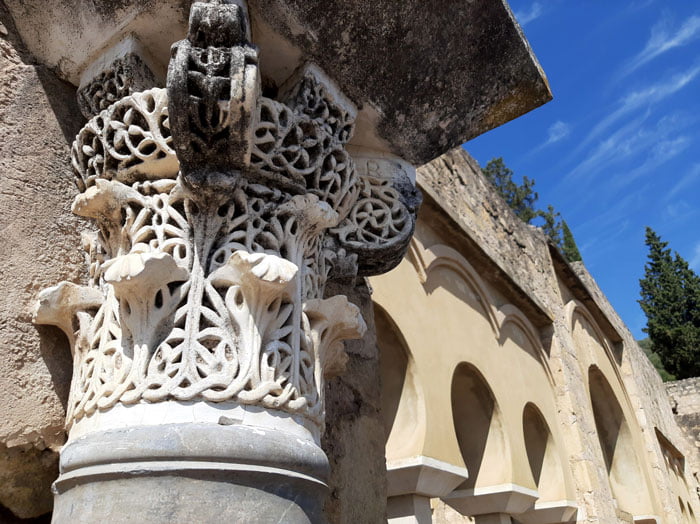
TIP: There are another 1,5 Euros to be paid at the entrance, but you will also be offered to see a short 12-minute-video. This is Madinat’s story displayed in 3D, extremely interesting.
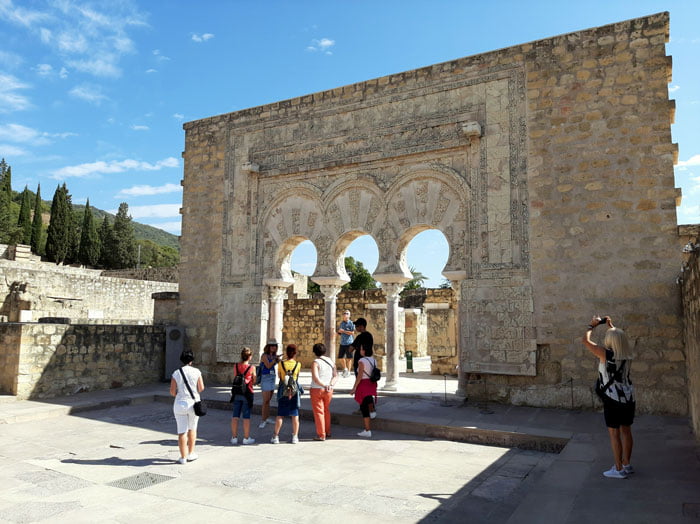
When you see the museum, you will take a “local” bus which rides to the actual palace for five minutes or so. (The same one is to be taken back to catch the yellow bus to Cordoba.) And there – the hill stretches with some great views and the remains of this 10-century beauty!
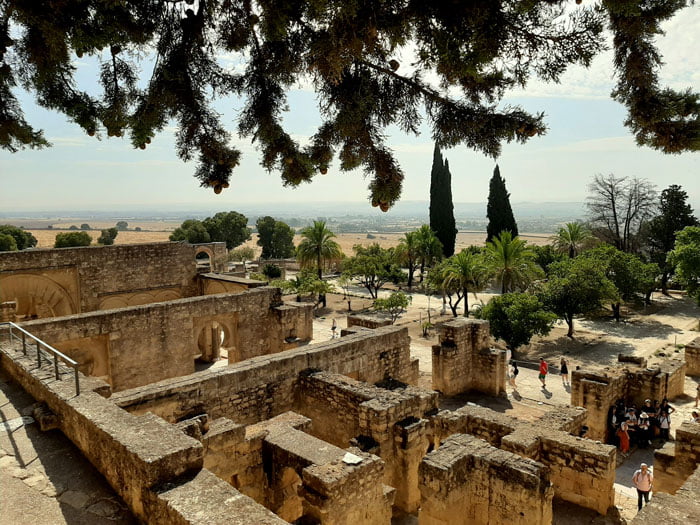
ALCAZAR IN CORDOBA
The Alcazar in Cordoba was built by Alphonso XI in 1328 in order to welcome queen Isabel and king Ferdinand. This is where Cristopher Columbus was received for the first time. Alphonso XI also built the old Synagogue, one of three that nowadays exist in Spain and the only one in Andalusia.
Even though it was built for the Christian monarchs, the architecture of the Alcazar is typically Moorish with fountains, ponds and aromatic herbs. (The entrance fee is 5 Euros.)
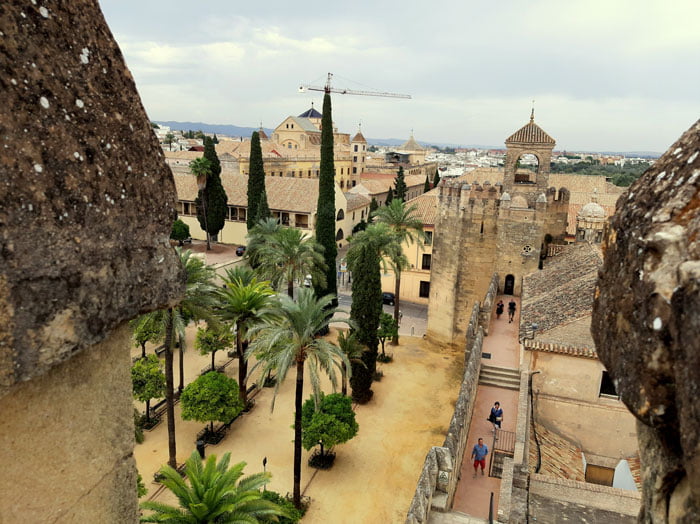
It’s easy to recognize Alcazar with its yellowish walls and the sand surrounding it. There is a breathtaking view of the Mezquita from one of its towers on one side, while its lavish garden lies on the other.
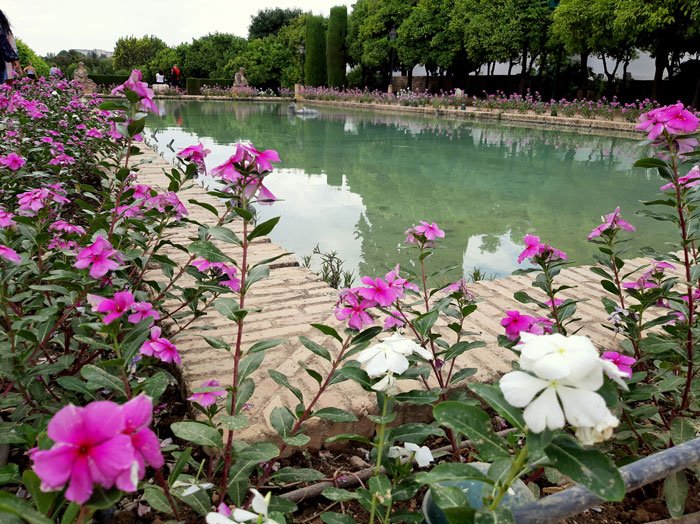
The former Inquisition chapel room is not to be missed, where Roman mosaics dating to the 2nd and the 3rd century are now displayed, excavated from the Plaza de la Corredera. There is also a large Arabic bathroom in the basement.
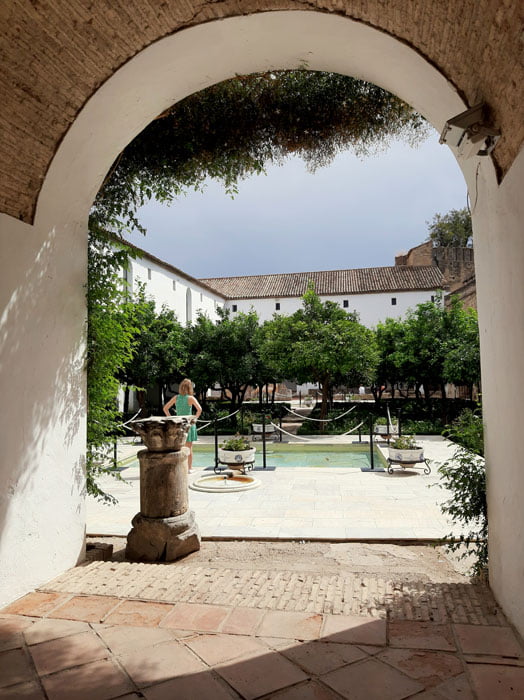
As soon as you walk into the lush garden, you immediately get the same urge as in any other Andalusian patios – to sit by the fountain and rest your eyes for a minute or two, with birds singing and purl of water in the background. (Did Columbus feel the same when coming here for the first time?)
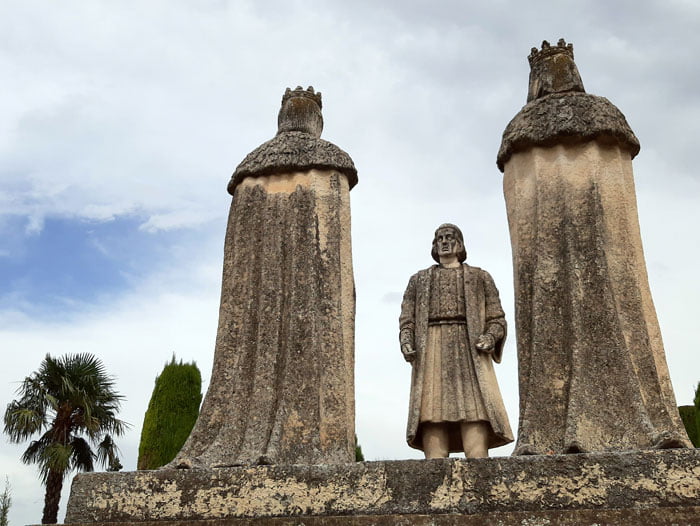
JEWISH QUARTER
The Jewish quarter or the Juderia is renowned for narrow streets, arches between white-washed houses and Andalusian patios filled with flowers. This is where the old Synagogue is, the only one in Andalusia, but also the monument to Sephardic scholar Maimonides who was born in Cordoba. Jews inhabited the area during Romans and Visigoths, and were the significant part of the intellectual elite under the Moors.
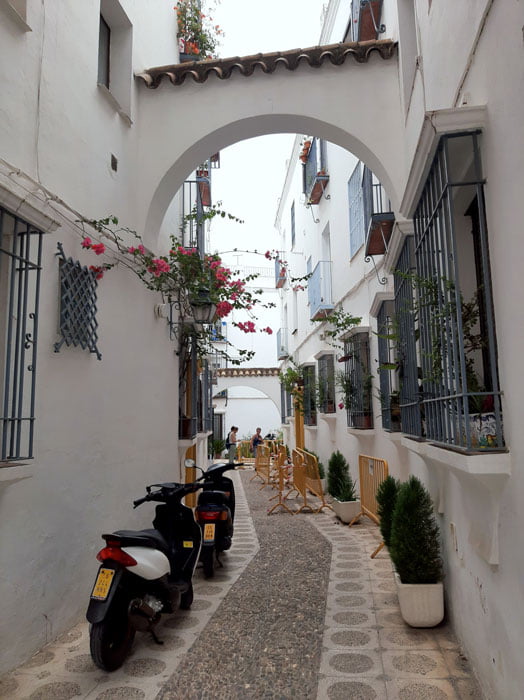
Did you know that Seneca and Ibn Rushd (or Averroes) were born here? While I walked towards the Jewish neighborhood, it crossed my mind how great Cordoba must have been 10 centuries ago when Ancient Greek philosophers were translated into Arabic, and then Latin (without which the western civilization couldn’t even dream of the Renaissance), when I reached the Ibn Rushd’s statue.

The man who translated the original Aristotle’s inscriptions, and wrote his own arguments on the margins, actively took part in contemplating the world in the potent intellectual 12-century Cordoba. No wonder the city became so famous as the center of knowledge and science, with a mixture of cultures and traditions.
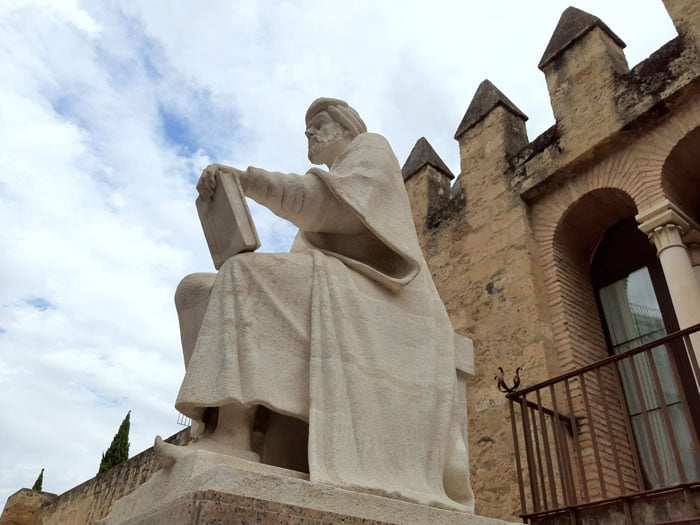
“I wish I could have seen how marvelous this knowledgeable hive was…”
Took numerous pictures of the statue, snap, snap!
“Well, maybe I have! I might have carried Ibn Rushd’s scrolls around, who knows, tripping over my galabia and being fluent in Arabic!”
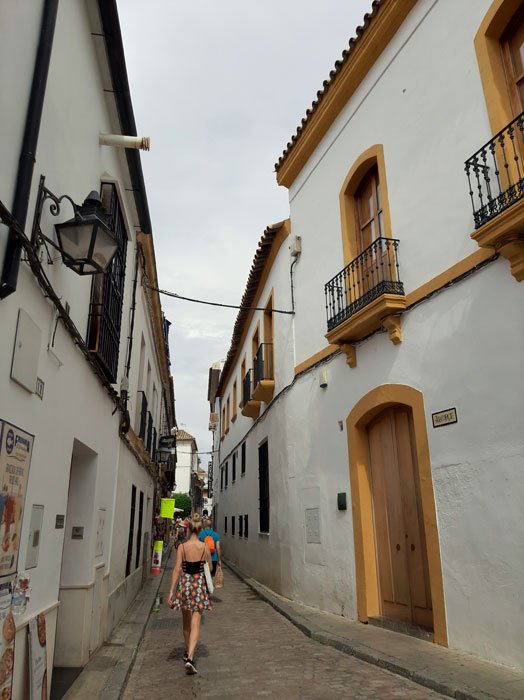
…Beautiful courtyard emerges before me – this is what you see in tourist guide books – the typical patio in the middle of the house. The place was crowded with tourists entering the Synagogue and the Andalusian House…
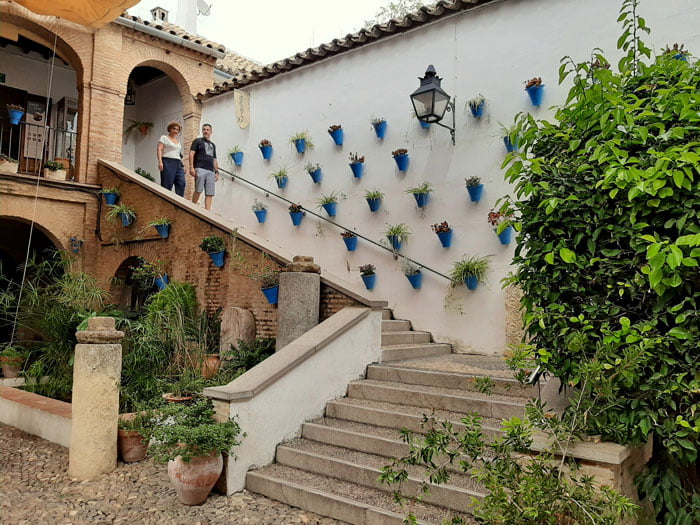
“And now, 1,000 years later”, my mind continues: “I graduated from the Faculty of Philosophy, took lessons in Arabic, and came back to greet the Cordoba scholar one more time! Like in the movies!”
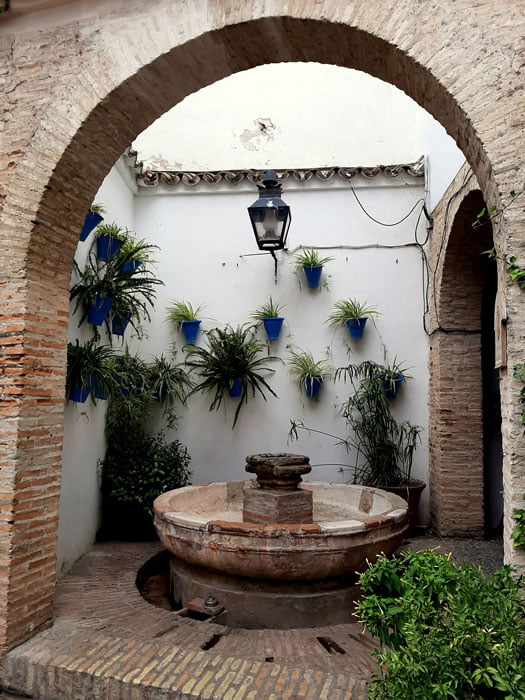
ROMAN BRIDGE
The first version of the bridge was erected over Guadalquivir river in the first century AD. It was reconstructed numerous times during these 20 centuries since then. The bridge connects the Mezquita and the Torre de Calahorra, the tower that was originally built by the Moors and reconstructed by the Catholics that now houses a museum.
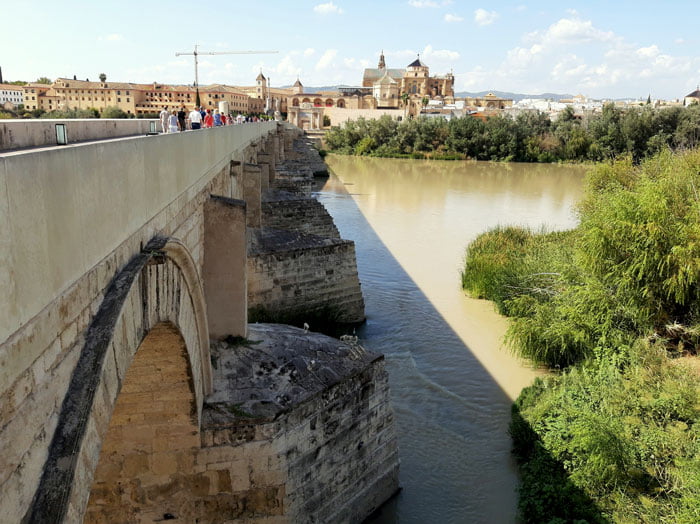
One cannot avoid seeing a picture of the heavy stone bridge with the Mezquita in the distance, right? Well, this is the very bridge. Although it’s a 20-century old, it still looks impressive, so make sure to put it on the things to do in Cordoba list. (Maybe you remember it from the Game of Thrones? This was the Long Bridge of Volantis that Tyrion Lannister and Varys were crossing when going from Pentos in a carriage, which they didn’t leave for days.)
TIP: If you fancy a visit to the Torre de Colahorra, make sure to ask about the opening hours,
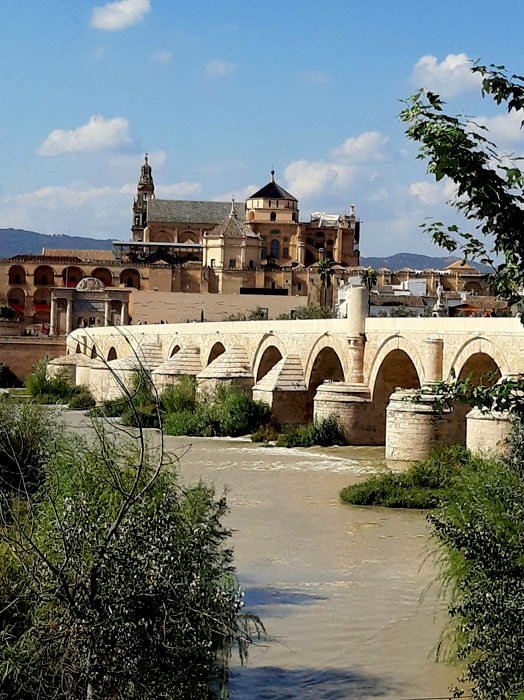
because just like shops and restaurants (which almost left me hungry a few times), museums also have lunch breaks and siestas. It will probably be closed between 14 and 16,30.
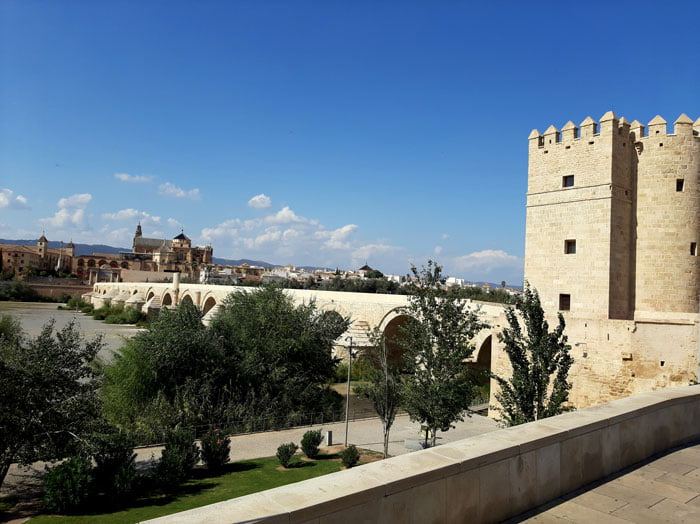
It was too hot (even in the middle of September), and I had to find something to eat, so the small restaurant next to the tower seemed like a nice idea. I found “tortilla de patates” specialty, and “pastel cordobes” dessert (the latter being like a tart with apples).
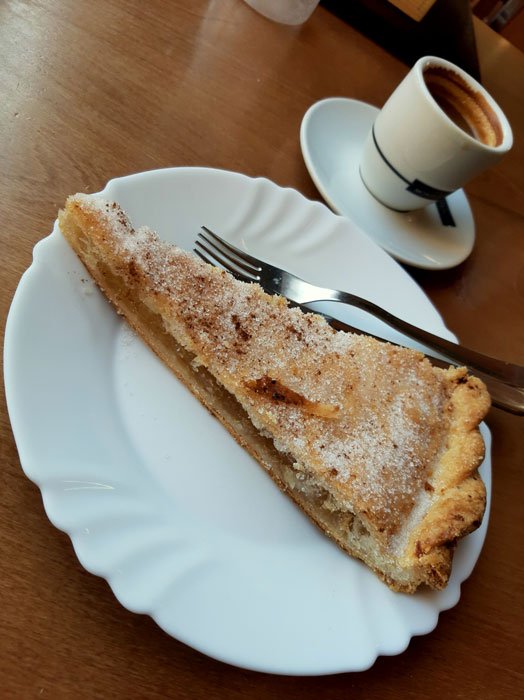
Two more Roman monuments are to be seen here – the so-called Bridge Gate, through which the city and the mosque were entered, and the Roman Temple. The temple is even more imposing considering that it is located in the city center with cars driving by and crowded restaurants surrounding it. (How lovely that my accommodation was also situated here.)
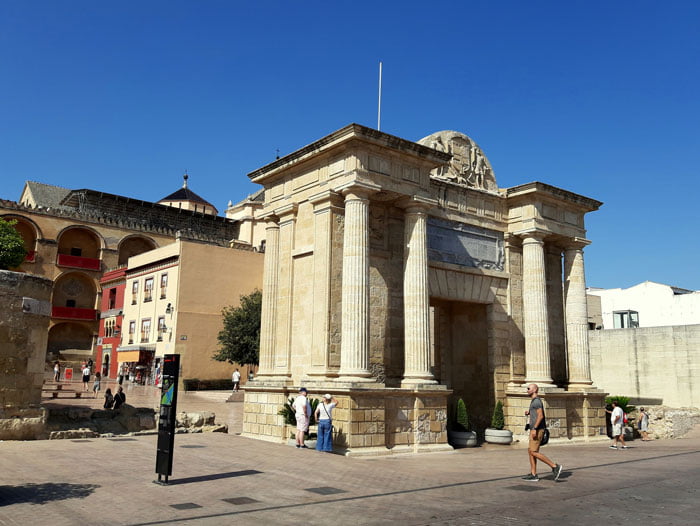
TIP: Make sure to avoid coming to Cordoba during summer. Due to its geographical position, the temperature here often reaches over 45 degrees, making the city one of the hottest in Spain.
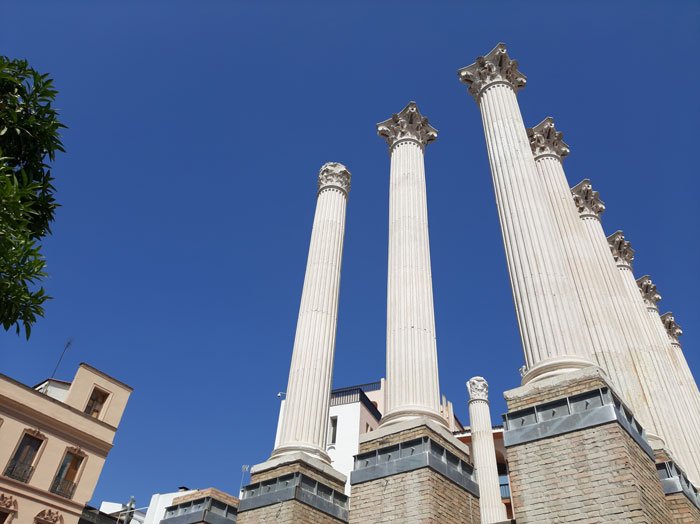
Don’t hesitate to walk around Cordoba and try avoiding larger streets, since the narrow passages are extremely charming and quite frequent. You will enjoy the stroll from Templo Romano to the Plaza de la Corredera, the vast plateau with restaurants and the vivid meeting point of Spaniards.
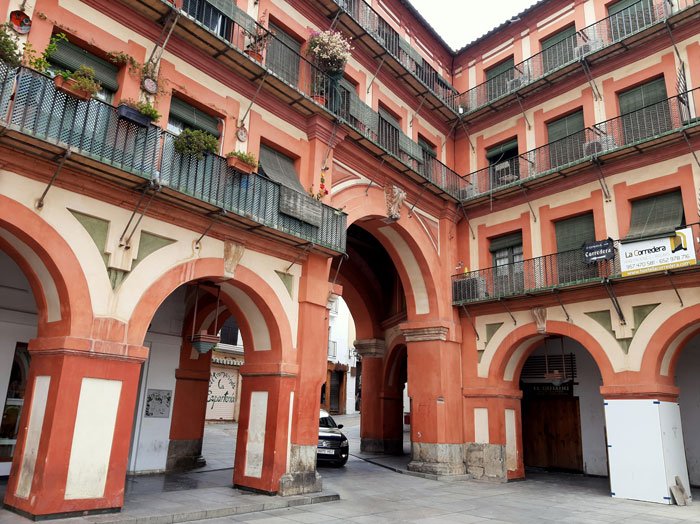
Plaza de las Tandillas is another vast square with restaurants, cafés, a huge fountain, and a lot of people. If you didn’t have your lunch around the Mezquita, at the Jewish quarter, or at the Plaza de la Corredera, consider having it here. It’s easy to find “menu of the day” deals (three-courses meals) for 7 to 10 Euros. Seafood “paella” is a must, along with the “flamenquin” (deep-fried rolled and sometimes stuffed ham).
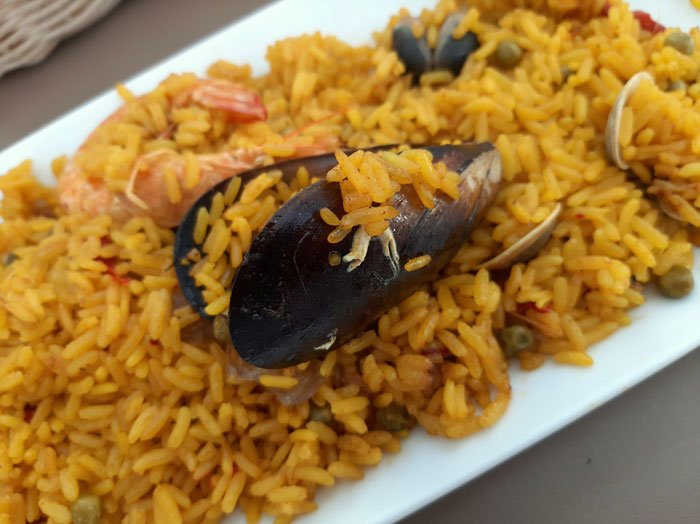
When I was on my way from Cordoba to Sevilla, I took an early morning departure bus ticket again and was planning to stroll one more time through the city. Nevertheless, it slipped my mind that the sun rises here as late as 8 am, making me walk to the bus station – in the dark.
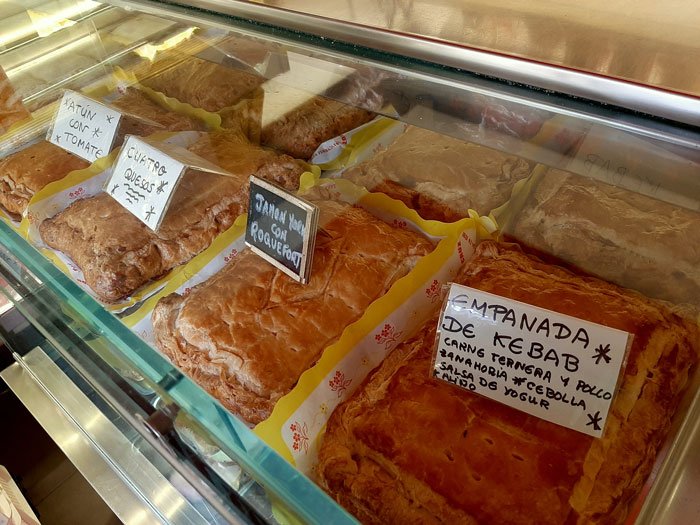
Still, nothing that one huge “empanada” for breakfast couldn’t cure. Not only that it was a fresh pastry with cheese, but it was big enough for two and so delicious! I managed to finish it pretty fast, though. (Luckily, it was still dark outside…)
Next: AND THEN I WENT TO SEVILLE…
The full ANDALUSIA series
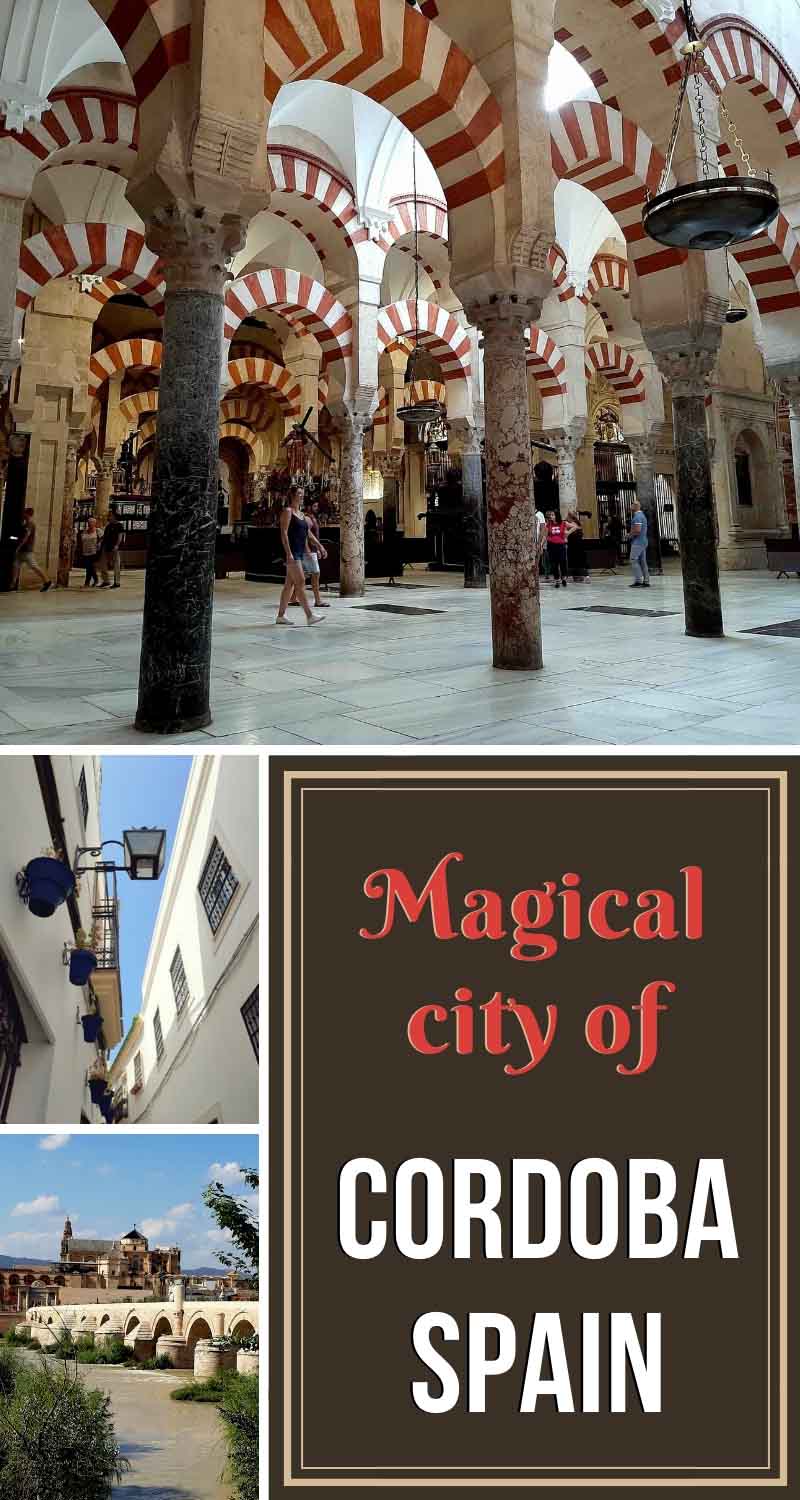
If you need a freelance travel writer or you would like to see your country, city, flight, etc., presented on the blog, drop me an email.
Find our more on Freelance Travel Writer page.
I am looking forward to working with you.
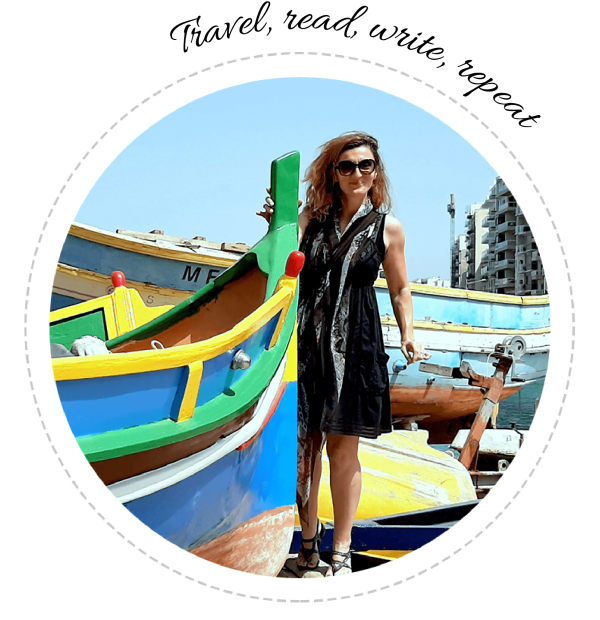



24 responses
Cordoba was the only city in Andalucia we were not able to visit. We visited Seville, Malaga, and Granada. I regret this very much seeing all this beautiful Landmarks that I missed!
As for me, Cordoba was the most important stop. I’ve been astonished for years by its history after I read about the Moorish legacy and architecture. So, it was only natural to be so impatient.
If you happen to go to Andalusia again, I would definitely recommend a visit to Cordoba. Thanks. 🙂
Your blog post took me back to Cordoba! We were stunned when we went inside the Mezquita. Rows and rows of columns went on forever. I can certainly understand why it took you 4 hours to visit. We are sorry we missed the Madinat Al Zahra. So fascinating that this was named for the favourite mistress. I can certainly see the romance in the architecture and the lace-like stone. Such a lovely city. And hard to believe it is much smaller than in earlier times.
I was thrilled by the Andalusian stories I heard on my journey. One of them is about the European ambassadors’ who visited the Madinat Al Zahra and their impression of the palace. (I mentioned it in the post.) And I can really relate to the impact the structure had 10 centuries ago, since I was blown away by its remains today.
Tourists tend to skip the palace, given that they usually come to Cordoba for a day or two, and they don’t have enough time. But it’s really worth a visit. 🙂
Such stunning architecture. The arches within arches are striking. I’m so excited to read this article because Andalusia, Spain is on our travel plans next year. I can’t wait to see this natural beauty for myself. Great shots!
I’m sure you’d love it. There is such a range of monuments to see, and delicious food to taste. 😉
Hope the post helps with your bucket list for Andalusia, thanks.
the photos look stunning! Andalusia looks amazing and the architecture alone is worth the visit. I have yet to visit that part of Spain and looking at your photos gives me even more reason to visit it sooner. The food looks good and sounds reasonable for around 10 euros for a three-course meal!
Spain is the country where you can eat well and it’s not that expensive. It can really fit any budget.
Museum and landmarks’ entrances can be a bit overwhelming, especially if you want to visit few a day, but a lot of those are usually free on Sundays.
Now I have to see Cordoba!! I’ve never been, and it seems like there is so much to do. I’d love to spend time in La Mezquita (and I’m with you, it would probably be 4 hours rather than 2 for us). It’s extraordinary. Seeing the uncovered Madinat Al Zahra would be fascinating, and even simple walks down the streets seem joyful. Thank you for sharing!
You clearly understand how the thrill of visiting a place like La Mezquita can make you stay for hours. Thank you, it’s so nice to hear that you like the post. 🙂
La Mezquita looks unreal! I would love to visit the andalusia region and experience the history and architecture for myself. I love Spain and have traveled quite a bit but havent made it to this region yet.
This was on my bucket list for years as well. And finally, it happened, and it was more than I have expected! 🙂
You’ve made me want to visit Córdoba even more than before! Mesquita looks incredible, And in can see why you got goosebumps! I tried Empanadas in Madrid and was immediately a fan!
So glad that the post made you want to go, thank you. 🙂
Oh, I know, I had to try different types of empadanas. 😛
I had no idea! What incredible architecture. I hope to visit the Alhambra one day but it looks like Cordoba has just as much to offer. The forest of columns!!
When the times comes for you to visit Andalusia, plan to spend three days in Granada to see the Alhambra and all the other beauties of the city, and at least two days in Cordoba. That way you won’t miss a thing. 🙂
(You’ll find more on Andalusia in the blog series, I’ll be writing about the seven towns I visited in September. You are welcome to stop by again.)
La Mezquita is stunning. You did a great job capturing the beauty too. I would also get dewy eyed! I’m curious about the red and white striped color scheme though. Was that also the original color scheme or creative addition later? Symbolic of sun beams maybe?
It’s the original color scheme. I even remember seeing the same pattern in the Syrian Grand Mosque in the old Damascus and some other Arabic buildings in the Middle East and north of Africa. But I have no idea what and if it represents something specific.
It would be extremely interesting if it was supposed to symbolize sunbeams, you’re right. 🙂
(If somebody knows more about it, please do share.)
Thanks, Vanessa. 🙂
Thanks for writing a detailed guide on things to do in Cordoba Spain. The Huge walls, architecture with 1300 columns and 365 colored arches in La Mezquita, is absolutely beautiful. Their thought of opening all the doors for creating an impression of extending orange trees is just wow. The details in mihrab area are mesmerizing. Madinat Al Zahra – the largest archaeological site of Spain, Alcazar Palace. Jewish quarters too are a must visit.
Thank you, so nice that you have the same opinion. 🙂
Gorgeous photos! Cordoba looks like a vibrant city with lots of things to do.
Thank you, so glad you like them. It is, I just loved the city. 🙂
WOW! How have I never heard of this place? What stunning architecture. I m in love with all those different types of arches and decore and the walkway with all the plants. Just wow!
I know, right! It’s even more beautiful in person. <3
Hope this travelogue comes useful if you decide to visit when this coronavirus situation is over. I would definitely go back. 🙂